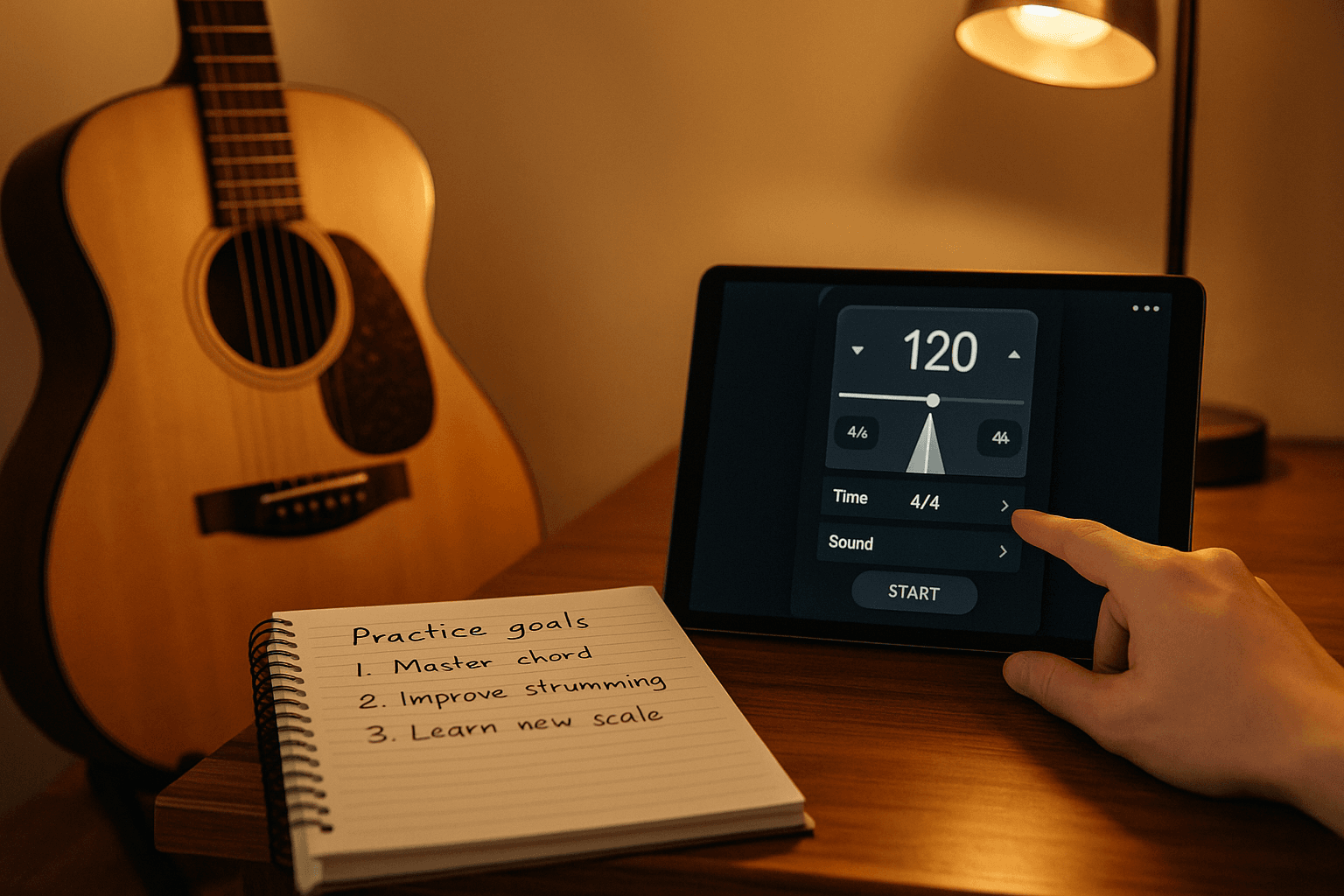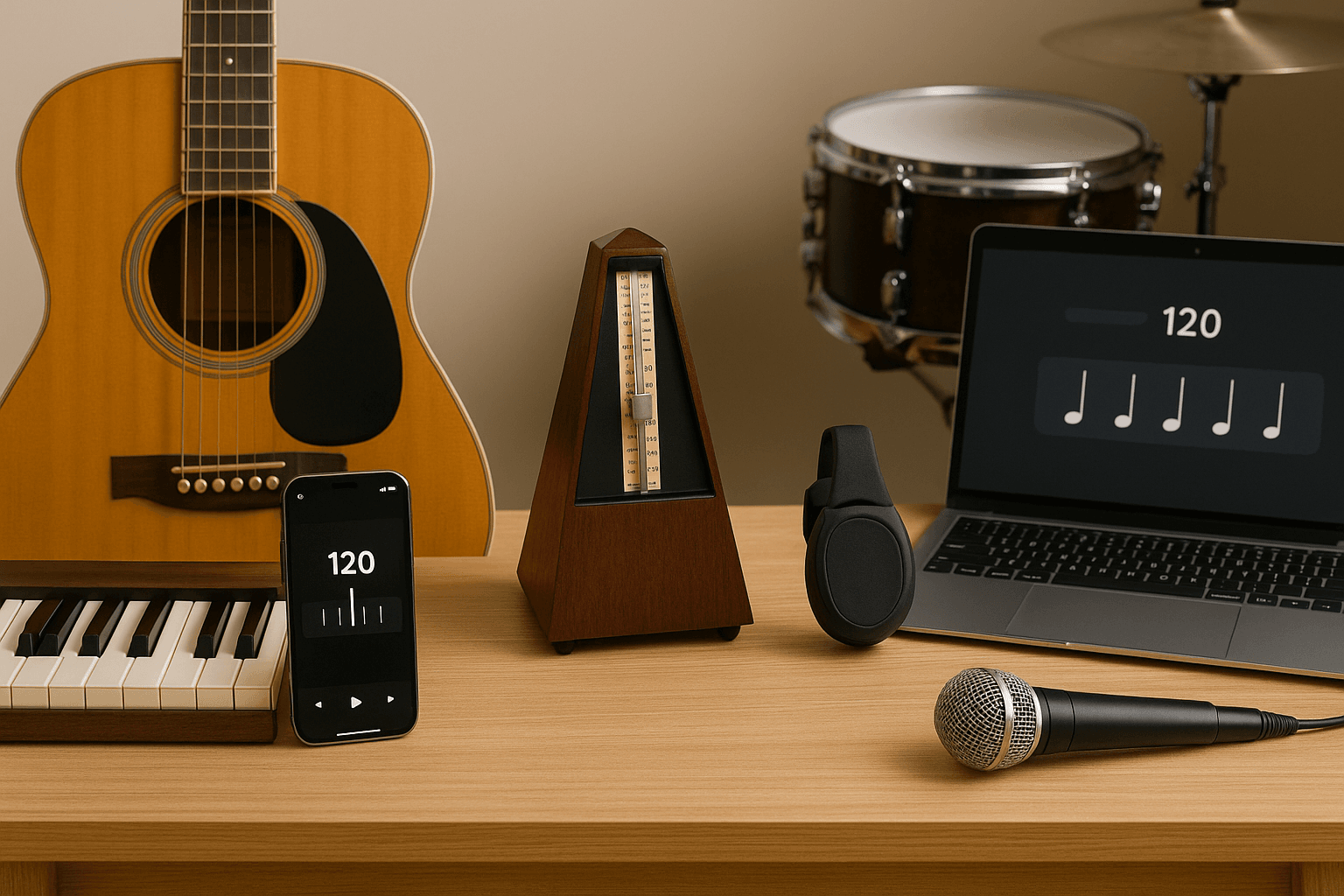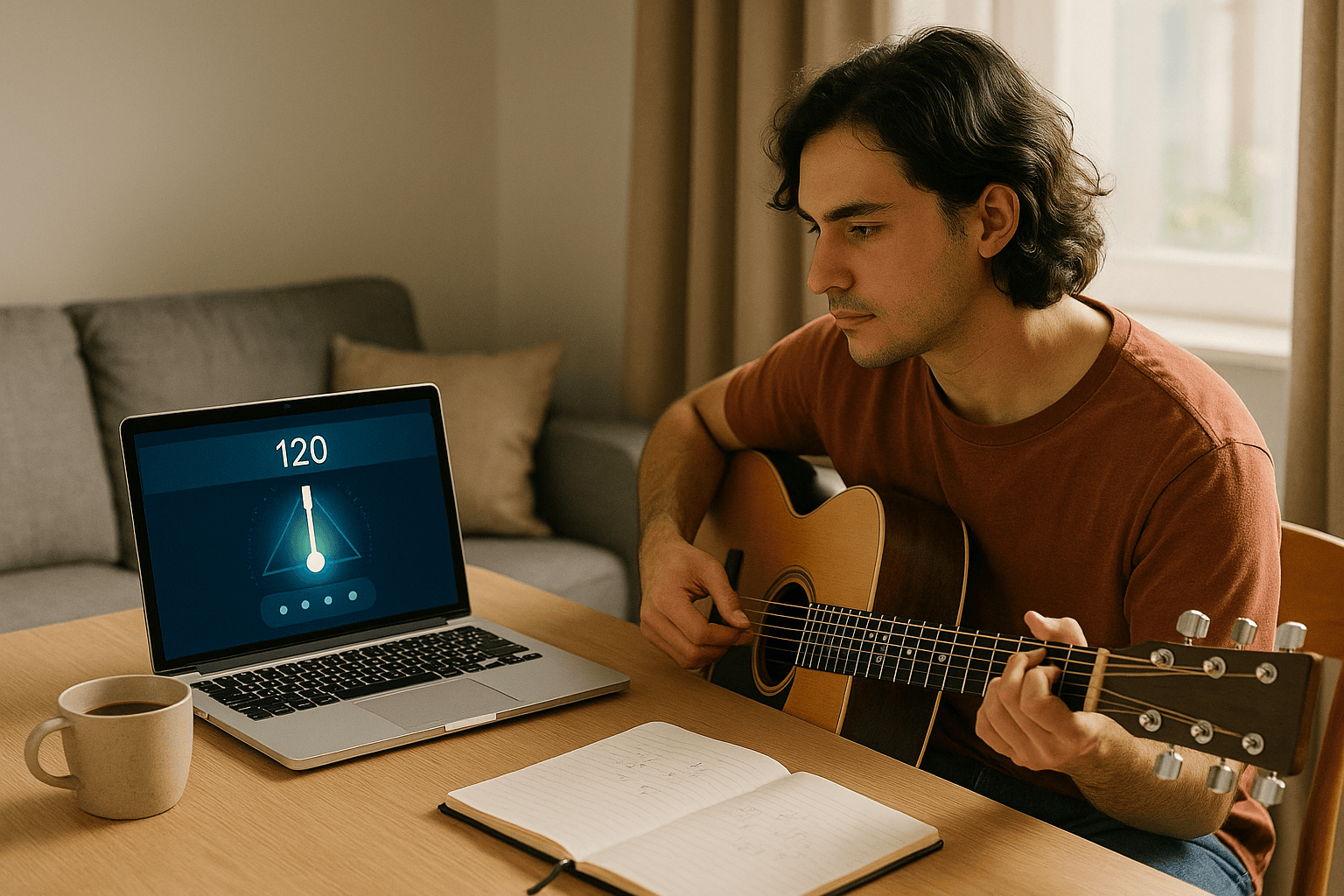Timing is everything in music, but how do you ensure your rhythm stays consistent whether you’re strumming your favorite guitar chords or practicing complex rhythms on the piano? This is where a metronome becomes your most trusted practice partner. From traditional mechanical metronomes to modern digital and electronic metronomes, these tools help musicians of all levels master timing, develop precision, and elevate their overall performance.
Whether you’re a budding guitarist aiming to improve chord transitions or an experienced musician looking to refine polyrhythms, using the right metronome can transform your practice sessions. In this guide, we’ll explore the best metronomes for guitar and other instruments, their unique features, and tips on integrating them into your daily practice. By the end, you’ll have the insights needed to choose a metronome that perfectly matches your musical journey—and maybe even discover a cool metronome that makes practicing more fun and engaging.
Top 5 Online Metronomes
 Finding the perfect metronome can feel overwhelming with so many options available online. Are you searching for a good metronome for guitar, or maybe a versatile tool that works across multiple instruments? Whether you’re practicing at home, on the go, or in a virtual lesson, an online metronome can make your practice sessions more effective and enjoyable.
Finding the perfect metronome can feel overwhelming with so many options available online. Are you searching for a good metronome for guitar, or maybe a versatile tool that works across multiple instruments? Whether you’re practicing at home, on the go, or in a virtual lesson, an online metronome can make your practice sessions more effective and enjoyable.
Here are five of the most popular and reliable online metronomes that musicians trust:
1. Soundbrenner Metronome
- Overview: A wearable metronome that combines vibration feedback with app integration, perfect for keeping your hands free while staying on beat.
- Why it’s great: Ideal for guitarists and drummers who want precise timing without relying solely on sound cues.
- Standout feature: Multiple metronomes for polyrhythm practice.
- Internal reference: Check out Art Gharana’s Online Guitar Classes to see how metronomes can be integrated into guitar practice.
2. Pro Metronome
- **Overview: Offers visual, auditory, and vibration cues to suit every learning style.
- Why it’s great: Supports customizable time signatures and subdivisions, making it perfect for advanced rhythm exercises.
- Standout feature: Tempo tap feature for real-time adjustments.
3. Metronome Beats
- Overview: A simple, user-friendly online tool that supports complex time signatures.
- Why it’s great: Perfect for beginners looking for a mechanical metronome alternative online.
- Standout feature: Visual beat indicators for easy follow-along practice.
4. Tonal Energy
- Overview: Combines a metronome with a tuner and sound analysis, designed for serious musicians.
- Why it’s great: Allows you to train with precision, whether you’re working on pitch, rhythm, or tempo.
- Standout feature: Interval Mute Mode for developing internal rhythm skills.
5. BeatSynQ
- Overview: Real-time synchronization across multiple devices, perfect for ensembles or virtual jam sessions.
- Why it’s great: Ensures all musicians stay in perfect timing together.
- Standout feature: Open Sound Control (OSC) support for live performances.
Using any of these online metronomes can dramatically improve your timing and rhythm, making practice more structured and effective. Whether you’re just starting out or looking to master advanced polyrhythms, these tools are essential additions to your musical toolkit.
Choosing the Right Metronome for Your Instrument
 Not all metronomes are created equal. The perfect metronome for a guitarist might not be ideal for a pianist, drummer, or vocalist. So how do you select a metronome that truly matches your instrument and practice style? Let’s break it down.
Not all metronomes are created equal. The perfect metronome for a guitarist might not be ideal for a pianist, drummer, or vocalist. So how do you select a metronome that truly matches your instrument and practice style? Let’s break it down.
1. For Guitarists
- Look for a metronome that allows tempo adjustments and supports polyrhythms—perfect for mastering chord changes and strumming patterns.
- Visual indicators can help when practicing intricate fingerpicking techniques.
- Pairing your metronome with tools like Guitar Chord Chart for Beginners can help integrate rhythm and chord knowledge effectively.
2. For Pianists
- A wide tempo range and clear auditory cues are essential for scales, arpeggios, and classical pieces.
- Consider digital or electronic metronomes that offer subdivisions for complex rhythms.
- Look for features like adjustable beat sounds to distinguish between strong and weak beats.
3. For Drummers
- Metronomes that support polyrhythms and unusual time signatures are extremely useful.
- Visual flash or vibration modes help maintain tempo during intense practice sessions.
- Some online metronomes also allow you to create custom rhythm patterns for advanced drum exercises.
4. For Vocalists
- Visual beat indicators can improve timing when practicing phrasing and breath control.
- A mechanical metronome alternative or online metronome with subdivisions helps internalize rhythm for complex vocal pieces.
- Combine your metronome with pitch training apps for comprehensive practice.
Choosing the right metronome is about more than just tempo—it’s about enhancing your musical precision and building confidence in your performance. The key is to select a metronome that complements both your instrument and your personal learning style.
Integrating Metronome Practice into Your Routine
 Have you ever wondered why some musicians seem effortlessly in sync while others struggle with timing? The secret often lies in consistent metronome practice. A metronome isn’t just a tool for keeping tempo—it’s a guide that helps you internalize rhythm, refine technique, and boost confidence during performances.
Have you ever wondered why some musicians seem effortlessly in sync while others struggle with timing? The secret often lies in consistent metronome practice. A metronome isn’t just a tool for keeping tempo—it’s a guide that helps you internalize rhythm, refine technique, and boost confidence during performances.
1. Set Clear Goals
- Begin each practice session with a specific objective: mastering a tricky chord progression, improving your strumming consistency, or learning a new scale.
- Using a mechanical or digital metronome with adjustable tempo can help you gradually increase speed without losing precision.
2. Build Consistency
- Short, focused sessions are often more effective than long, irregular practices.
- Aim to practice daily or several times a week, even if it’s just 10–15 minutes with your metronome.
3. Mix Techniques and Instruments
- Rotate between scales, arpeggios, chord transitions, or rhythm exercises while keeping the metronome running.
- For guitarists, pairing timing practice with a structured guide like Master Guitar Scales Guide can enhance skill development while keeping your sessions engaging.
4. Track Your Progress
- Record yourself to identify timing inconsistencies.
- Gradually increase tempo as your accuracy improves, challenging yourself without feeling overwhelmed.
By integrating metronome practice thoughtfully into your routine, you’ll notice measurable improvements in rhythm, timing, and overall musicality. Over time, your good metronome for guitar or digital tool will feel like a natural extension of your practice sessions, helping you perform with confidence and precision.
Master Your Timing and Elevate Your Music
 So, are you ready to take your rhythm and timing to the next level? Whether you’re a budding guitarist, a seasoned pianist, or a vocalist looking to refine your precision, the right metronome can transform your practice sessions into focused, productive, and even enjoyable experiences. By choosing a mechanical, digital, or electronic metronome that fits your instrument and integrating it consistently into your routine, you’re setting yourself up for noticeable improvements in accuracy, confidence, and overall musicality.
So, are you ready to take your rhythm and timing to the next level? Whether you’re a budding guitarist, a seasoned pianist, or a vocalist looking to refine your precision, the right metronome can transform your practice sessions into focused, productive, and even enjoyable experiences. By choosing a mechanical, digital, or electronic metronome that fits your instrument and integrating it consistently into your routine, you’re setting yourself up for noticeable improvements in accuracy, confidence, and overall musicality.
Remember, it’s not just about keeping time—it’s about developing a deeper connection with your music. Each click, pulse, or visual beat is an opportunity to grow, to challenge yourself, and to perform with precision. Ready to make every practice session count? Start exploring the tools that suit your style, embrace the rhythm, and watch your skills flourish.

 Finding the perfect metronome can feel overwhelming with so many options available online. Are you searching for a good metronome for guitar, or maybe a versatile tool that works across multiple instruments? Whether you’re practicing at home, on the go, or in a virtual lesson, an online metronome can make your practice sessions more effective and enjoyable.
Finding the perfect metronome can feel overwhelming with so many options available online. Are you searching for a good metronome for guitar, or maybe a versatile tool that works across multiple instruments? Whether you’re practicing at home, on the go, or in a virtual lesson, an online metronome can make your practice sessions more effective and enjoyable. Not all metronomes are created equal. The perfect metronome for a guitarist might not be ideal for a pianist, drummer, or vocalist. So how do you select a metronome that truly matches your instrument and practice style? Let’s break it down.
Not all metronomes are created equal. The perfect metronome for a guitarist might not be ideal for a pianist, drummer, or vocalist. So how do you select a metronome that truly matches your instrument and practice style? Let’s break it down. Have you ever wondered why some musicians seem effortlessly in sync while others struggle with timing? The secret often lies in consistent metronome practice. A metronome isn’t just a tool for keeping tempo—it’s a guide that helps you internalize rhythm, refine technique, and boost confidence during performances.
Have you ever wondered why some musicians seem effortlessly in sync while others struggle with timing? The secret often lies in consistent metronome practice. A metronome isn’t just a tool for keeping tempo—it’s a guide that helps you internalize rhythm, refine technique, and boost confidence during performances. So, are you ready to take your rhythm and timing to the next level? Whether you’re a budding guitarist, a seasoned pianist, or a vocalist looking to refine your precision, the right metronome can transform your practice sessions into focused, productive, and even enjoyable experiences. By choosing a mechanical, digital, or electronic metronome that fits your instrument and integrating it consistently into your routine, you’re setting yourself up for noticeable improvements in accuracy, confidence, and overall musicality.
So, are you ready to take your rhythm and timing to the next level? Whether you’re a budding guitarist, a seasoned pianist, or a vocalist looking to refine your precision, the right metronome can transform your practice sessions into focused, productive, and even enjoyable experiences. By choosing a mechanical, digital, or electronic metronome that fits your instrument and integrating it consistently into your routine, you’re setting yourself up for noticeable improvements in accuracy, confidence, and overall musicality.